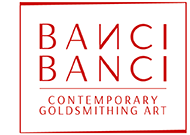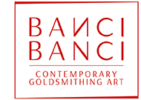Architecture is one of the keystones in Daniela and Marzia Banci’s training and artistic evolution. Among the figures who have contributed towards enhancing the exhibition Tradition in Modernity there is Vittorio Spigai, who both artists met while at university in Venice.
Vittorio Spigai is Tuscan and essentially a painter. He graduated with an engineering degree in Rome with Vittorio De Feo and with an architecture degree in Venice with Carlo Aymonino. Between 1971 and 2011, he taught Composition at the IUAV in Venice. As an urban planner and architect he drew up Trieste’s development plan and several great projects, including the new campus for the School of Economics at Cà Foscari in Venice, in the area of the former Le Corbusier Hospital. Since 2009, he has been working on the restoration of the stunning Renaissance walls of Padua, the best-preserved in the world.
Here is a passage from his conversation with the two goldsmiths.
Happy reading!
As an architect and university professor, how do you teach the value of space?
Space in architecture can’t be restricted to internal space, it isn’t only that.
What is essential is the relationship between the internal space of buildings and their external context – the squares, streets, the views of the countryside and nature in general. Buildings in themselves, as objects standing in their small green patches, are the models that have destroyed European cities and our landscapes since the 1940s. Although interior space has its own value, of course, this value is multiplied when it interacts with city public spaces, with gardens and the landscape. To give you an example, in the past, even the humblest of Veneto villas – with a large room on the piano nobile opening on to a garden or even a driveway – upheld these values.
Which contemporary architectural work best embodies our times and why?
Precisely for Jean Nouvel’s bold solution to making a building and its surrounding lake, city and landscape interact, I think the KKL Concert Hall in Luzern, which was inaugurated in 2000, is a masterpiece. Although perhaps it doesn’t mirror our times, and certainly not the situation in Italy where, unfortunately, good public architecture is made almost impossible by overburdening laws and regulations.
Living spaces in homes, cities, cultural buildings, work quarters– how has the planning of these places changed over time?
Cities and architecture represent the society which produces both. In the past, educated patrons didn’t allow the construction of public and private buildings that didn’t enhance the beauty of public spaces and the city in general. Today, even the most important buildings are an insult to past urban planning, to the care a profoundly civilised society put into building fortifications, bridges, houses and even factories. For instance, think about the elegant, ‘urbane’ public housing and healthcare facilities of the 1800s and early 1900s. Undoubtedly emotive issues, if we consider the eyesore hospital facilities built in the Veneto and in particular in the centre of Padua in recent years.
A painter and an architect: how and when do they overlap and when are they happily different?
I wouldn’t speak of overlapping. In the end, if we take a closer look, they are the same thing. Given that the skills required are different, of course, if you can master both technically, then the dedication is the same. Architecture is perhaps easier, less acrobatic, so to speak, because part of its contents is necessarily objective. In painting, you are alone and the content is what you want to communicate to yourself and the world. You are barehanded with a beast that might wriggle away or hurt you, hug or disappoint you any time.
Banci Banci, two goldsmiths who trained as architects – can you perceive this approach in their works?
The Bancis certainly share a common trait, which is their constant search for rationale in conceiving and carrying out their works. Which means planning. And this is a cornerstone in all architecture schools from the very beginning, but may also be a dangerous tie. In the Bancis’s works, creativity flows freely while planning brings rigour.
Jewellery is art to be worn, and in our case, an extension of our personality. Is the choice of space and living spaces so private, too?
As I said before, the space of good architecture isn’t only private and personal, it is, in fact, open to its context and community, it’s a means. Similarly, although jewels are worn close to the body, they also engage the viewer, who is attracted to them as an unconscious beneficiary. This is why, when jewels draw from sculpture, they hit the nail right on the head. And perhaps this has always been the challenge for goldsmithing art. Just like architecture, it has a double intrinsic value, to produce everyday objects and be a communication subject.
If you were asked to design a museum for contemporary jewellery, what devices would you consider indispensable?
As for painting, I wouldn’t want a contemporary museum for the art of jewellery-making. It’s far more enthralling to make splendid jewels of different historical periods interact with contemporary ones, emphasising similarities, differences – there are many ways. And at the same time make the museum interact with the city. For instance, coming up with ideas to merge interior and exterior spaces through lighting and security systems, so that the museum isn’t closed up in itself but blends in and enriches the quarter, like a large walk-through window that adorns the city. In short, neither stuck in its century, nor locked inside its building.



